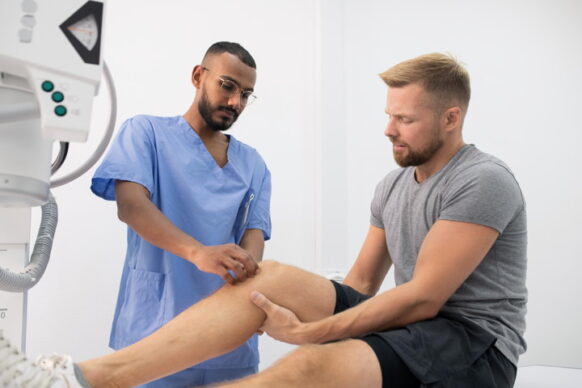What are Common Hip Problems and How are They Treated? – Dr. Robert Thornsberry
Hip pain is a very common problem seen in the orthopedist’s office. Luckily, most hip injuries are minor and can be treated conservatively. However, occasionally there are significant problems that need to be addressed by more aggressive methods. Over the past several years, technology has come a long way in the treatment of hip injuries. Orthopedists are now able to perform minimally invasive surgery such as arthroscopy to treat even complex hip problems.
How Does the Hip Work?
The hip joint is a relatively simple ball and socket joint. The top of the femur or thigh bone is a round ball which fits into a hemispheric socket in the pelvis called the acetabulum. The joint is covered by a thick capsule which helps hold the bones in place. Surrounding the hip are 15 muscles that help to guide the hip’s motion. On the outside of the hip between the bones and muscles are several sacks of fluid called bursa that can become inflamed.
What are the Most Common Hip Injuries?
The most common injuries to the hip involve muscle sprains and strains. The various muscles attach all around the hip, both front and back. The muscles can be pulled by any mechanism that overstretches the muscle, such as a split or a fall. Most muscle strains are at the level where the muscle joins the tendon, not at the level where the tendon attaches to bone. These strains respond to ice and rest, followed by gentle stretching. Most will heal within several weeks. Occasionally, physical therapists can assist in rehabilitating the more serious muscle strains or muscle tears.
What is Hip Bursitis?
As mentioned before, on the lateral side or outside of the hip is a bursa. The thigh bone makes an angle on its entry into the hip. The prominence that one can feel on the outside of the hip is the greater trochanter. It is an area where several significant muscles insert to help hold the hip level as one walks. Overlying this area is a thick tendon called the iliotibial band. Between the trochanter and the iliotibial band is a bursa. The bursa acts as a lubricant to allow the band to slide over the trochanter. The bursa can become inflamed. This condition is called trochanteric bursitis. It can be extremely painful. Diagnosing bursitis is easy; treating it can be difficult. Again, stretching and physical therapy are key. Other times, an injection of corticosteroid can be beneficial. Very rarely, if the problem persists, surgery to remove the bursa and tight iliotibial band is necessary.
What is Hip Impingement?
One of the newer innovations in orthopaedics has been hip arthroscopy. The arthroscope is a small camera that can be inserted into the hip joint via a small incision. It allows the orthopedist to evaluate the hip joint with minimal morbidity. Special instruments designed for the hip allow the surgeon to treat certain conditions. One of these conditions is hip impingement. Hip impingement is caused by a small bone spur that causes pinching between the femoral head and the acetabulum. With the arthroscope, the surgeon can remove the spur and repair the socket without having to make a large incision and cut muscles. This leads to much less pain and a faster recovery.
Treatment for Hip Arthritis in Central GA
Sometimes the hip just plain wears out over time. When the cartilage on the end of the femur and in the socket wear down, the hip becomes arthritic. Hip arthritis can be very painful and debilitating. When the pain gets severe enough, a hip replacement is required. A hip replacement is a big operation, but very successful. It can change people’s lives and keep them active. It involves removing the head of the femur and reaming the socket to prepare them for a metal stem in the femur and a metal cup in the socket. A plastic bearing lies between the two, allowing motion. Patients can walk immediately after surgery.
About Dr. Robert Thornsberry
Dr. Robert Thornsberry, the author of this article, is one of our fellowship-trained sports medicine specialists at OrthoGeorgia. He is board-certified in Orthopaedic Surgery and has a particular interest in athletic injuries, ACL reconstruction, arthroscopy of the shoulder and knee, fracture care, total joint reconstruction, and resurfacing of the knee. Dr. Thornsberry was the first orthopaedic surgeon in Central Georgia certified to perform a Robotic Arm Assisted Knee Surgery (MAKO) for resurfacing of the knee. Patients can meet with Dr. Thornsberry at our offices in Macon and Milledgeville.
Care for Hip Pain and Injuries in Central Georgia
Listed above are just a few of the many causes of hip pain. Key to the treatment of any painful condition is a proper diagnosis. Once a proper diagnosis is made, most problems can be taken care of in a simple manner. When the problem is more complicated, there are viable alternatives including surgery which have proven to be successful. If you are facing a hip condition or injury, our physicians at OrthoGeorgia will work with you to help you get back to living your most active life. Our orthopaedic surgeons specialize in spine, hand, sports medicine, foot & ankle, and total joint care. We will ensure that all of your questions are answered while providing expert care that is personalized to you. To schedule an appointment or learn more about the care we provide in Macon, Macon Spine and Orthopaedic Center, Warner Robins, Kathleen, Milledgeville, Dublin, and Hawkinsville, please contact OrthoGeorgia today!

Personalized Orthopaedic Care in Central Georgia
At OrthoGeorgia, we want to help you live a healthier and more comfortable life by giving those in Macon, Warner Robins, Kathleen, Milledgeville, Dublin, Hawkinsville, and the surrounding areas convenient access to the highest quality care. Whether you have been suffering from a sports injury or a common orthopaedic condition, we will determine the cause of your discomfort and craft a personalized treatment plan to bring you relief. To learn more about our services and our physicians, or to schedule an appointment at OrthoGeorgia, please contact us today.







